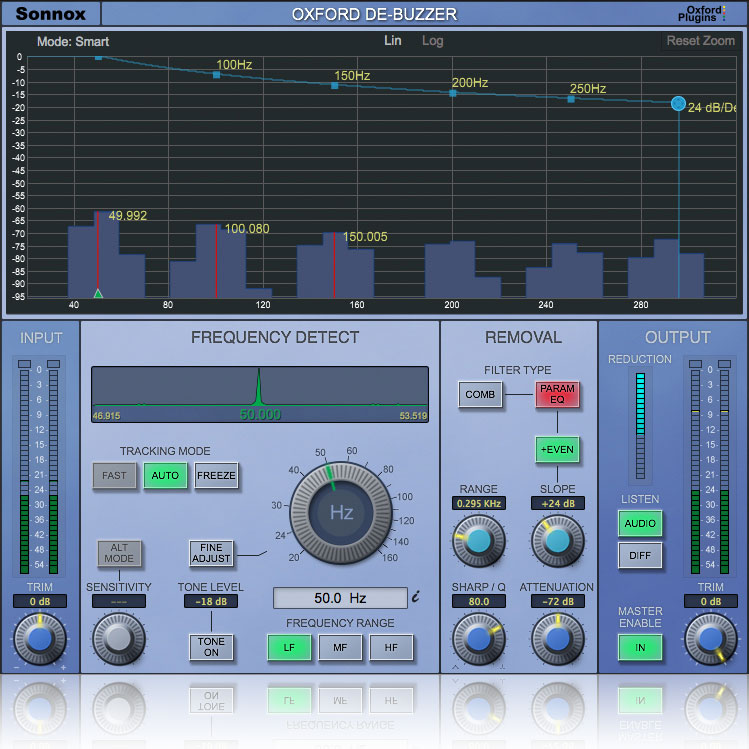You're currently on:

The Oxford DeBuzzer is divided into two stages: Detection and Removal.
Buzz removal is usually accomplished using a comb filter. The comb filter has many tight notches that eliminate the fundamental frequency and associated harmonics of the buzz. For this process to work well, the fundamental frequency must be very accurately determined.
The DeBuzzer has several ways of helping isolate the fundamental frequency.
First is the Peak Profile that is displayed above the central rotary control, which shows the strength of a given nominal frequency in the input signal. Second is the large FFT display which accentuates any frequency components that are consistently present, making them stand out in the plot. It will automatically mark the three highest peaks found, and you can set the nominal frequency by clicking one of the peaks on the graph.
The third method of isolating the fundamental frequency is a tone generator. In the same way as you can tune a guitar, as you home into the fundamental, the beat frequency between the tone and the fundamental will become slower and slower the closer you get.
Three Tracking Modes
The DeBuzzer has three modes, Fast, Auto and Freeze. By default the plug-in assumes Auto mode, continuously hunting either side of the nominal frequency for a peak profile. Once the lock strength rises to be above a certain level, the plug-in automatically sets the nominal frequency to the frequency of the peak found. If the hum is wandering in frequency, the detector will follow. Auto Mode is suitable for tracking a weak, slowly wandering fundamental and operates over all three frequency bands. Fast tracking mode allows the removal filters to automatically follow a quickly wandering fundamental.
In Auto Mode the nominal frequency is set with the large central rotary to within about 5Hz of a 50Hz or 60Hz hum frequency, the plug-in will automatically move towards the detected frequency and set itself up to remove it. Once the hum has disappeared, Freezemode can be selected to set the nominal to this exact frequency and stop the detector from hunting.
The large central rotary control can be setup to control three frequency ranges, determined by the LF, MF and HF buttons, and can be set with a very fine resolution of 1/10,000Hz
For removing whines and whistles it is best to set Freeze Mode, and then use the FFT to find the frequency of the whines. These show up as peaks on the plot, and then you can click on a peak to set up the plug-in to remove that frequency.
Filter Choice
In terms of the removal filters, the default is a comb filter. However, you can override this by selecting Para-EQ mode, which means using parametric EQ sections to remove the fundamental and harmonics. If the buzz contains many harmonics, or if the frequency of the buzz is wandering, it is best to use the Comb filter. If there are only one or two harmonics to remove, then you may find that you prefer the sound of the parametric EQ filters.
In Para-EQ mode you can reduce attenuation as you increase in frequency, with the Slope control, and you can choose to notch out odd and even harmonics, as opposed to only odd harmonics.
Output
The listen section of the Output Panel contains an option to listen to the difference between the input and the processed output. This is labeled 'Diff' and is particularly useful for hearing what has been repaired, and for listening to the quality of the repairs without being distracted by the audio material.
| Variant | 1 |



